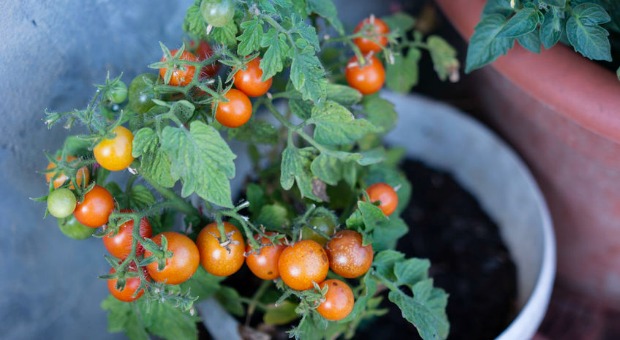You start by planting seeds and hope to have a small crop but they don’t even sprout. Or you buy healthy seedlings and they just come to your home to die.
Your container gardening is just not working…
Just like with flat gardening, you’ll come across some problems when you’re practicing container gardening, too.
Are you going to give up before reading how these 8 problems can be solved?
Plants grow but don’t produce fruit
There’s nothing more frustrating than watching your plant grow from a seedling into a lush, beautiful plant, then waiting for fruit that never comes.
There are a couple of different reasons that this may happen.
Plant isn’t pollinated
If you’re growing plants that require cross-pollination, they won’t bear fruit if they aren’t pollinated. Usually, bees take care of this, but not always, especially if your containers are in a protected area or you live somewhere with a small bee population. These plants include squash, watermelon, cantaloupe, and some cucumbers to name a few.
To pollinate them so that they bear fruit, simply take a small, soft paintbrush and gently run it around the inside of each flower. Don’t forget to do the first one twice!
If you still have a problem, you may not have both male and female plants. Female plants may not develop if the weather is cold or too wet. You can determine which flowers are male and which are female, by their appearances. If you do this, then you can just pick the male flowers (only females bear fruit) and pollinate the females with those.
The easiest way to tell if many plants are female or male is to look at the base of the flower. For instance, with squash, the female flower will have a little squash underneath it at the base of the stem and a raised orange structure inside. The male will just have a stem on the bottom, but there will be an anther with pollen on it inside of it.
This will vary from plant to plant, so know how to tell the difference on your individual plants. Usually, though, the presence of the pollen-covered anther will be a dead giveaway.
Video first seen on Tower Garden.
High temperatures or humid/arid conditions
Another reason that your plant may get bushy but not produce fruit is because they won’t produce if the temperature is too high or if the pollen can’t spread. This is particularly applicable to tomatoes and peppers.
If the temperatures regularly reach 85-90 degrees during the day and 75 degrees at night, the plant may not set fruit. If it’s too humid, the pollen may be too sticky inside the flowers to spread from flower to flower. If it’s too arid, the pollen may be too dry.
The best solution here is to protect your plants from the heat as much as possible, and make sure that they’re fed and watered correctly. Even though most people will tell you that tomatoes and peppers prefer full sun, if you live in places such as the southern US where temperatures can be brutal, “full sun” means “full sun in the morning.”
Plant your seedlings where they’ll get full sun in the morning but shade in the afternoon.
Learn from our ancestors the old lessons of growing your own food!
Seeds Don’t Sprout
This is incredibly frustrating. You’ve taken the time to choose your seeds and plant them, then you wait … and wait … and wait. And nothing happens. No seedling pokes through. What went wrong? Well, again, it can be a couple of things.
Seeds were too old
Seeds are only good for an average of a couple of years – some seeds may be good for up to five years – but don’t count on them for more than two years. To make sure that your seeds are good, germinate a few of them before you plant the rest.
Do this by placing ten seeds, evenly spaced, in a wet paper towel. Roll it up and put it in a baggie, then put the baggie in a warm spot in the kitchen for two to seven days. Check the seeds after then and see how many of them germinated.
The number of seeds that germinated will give you a good idea of the percentage of the other seeds that will germinate, thus giving you an idea of how many to plant in order to get the yield you’re looking for.
Incorrect amount of water
This is possibly the most common reasons why seeds don’t germinate. Some seeds, such as tomato seeds, like plenty of water. Others, like peppers, germinate better when the soil is fairly dry. The only solution here is to know what conditions your particular plants require in order to germinate the best.
Planting too deeply
This is a common mistake made by new gardeners. Most seeds don’t need to be planted more than an inch or so beneath the soil. Planting them deeper will either delay the appearance of the sprout or cause the seed not to germinate at all.
Planting in cold soil
Most plants need the soil to be at least 50 degrees in order to germinate, and 65 is better. If you live in an area that gets extremely cold, start your plants inside in order to get your seeds to germinate. A combination of planting too deeply and planting in cold soil is the most common reason for seeds not to germinate.
Plants have mold
You may notice a white mold growing on the top of your soil. This in itself isn’t cause for concern, though you do need to change the environment around your seedlings. The soil is either too wet or it isn’t getting enough sun, or both.
The white mold actually helps organic matter decompose, but you don’t want it to grow in your plants. Don’t freak out, though. It doesn’t mean instant death. Scrape the mold off the surface of the soil, then don’t water your plant again until the soil dries out.
Setting up a fan to circulate air may help, too. Just put it on a setting that causes the leaves to flutter.
Your plants may also get what looks like a white film over the leaves. This is actually powdery mildew and is one of the most common and easily identifiable fungal disease in plants. Unlike mold, mildew favors dry foliage. Like mold, though, it also favors low light and high humidity.
You have a few effective natural treatments, but the best is vinegar. Combine 2-3 tablespoons of ACV with a gallon of water and spritz on the leaves a couple of times a week until the mildew disappears. Be careful though, because vinegar can burn the plant. A combination of 1 part milk and 2 parts water is strangely effective, too.
Nobody really knows why, but it works! Sulfur and lime/sulfur works, too, but can easily damage your plants, so try the vinegar or milk first.
Video first seen on ehowgarden.
Other common problems to container gardens
Plants wilt even with enough water
Cause: insufficient drainage.
Tip: increase drainage holes, use a lighter soil mix.
Plants are “leggy” (spindly and unproductive)
Cause: not enough light.
Tip: relocate the plants.
Leaf edges die
Cause: too much salt.
Tip: leach container regularly by watering until water drains from drainage holes.
Plant turns yellow at the bottom
Cause: too much water.
Tip: water less and ensure good drainage.
These are most of the problems that you’ll run into with container gardening, aside from insects and other diseases.
If your plants become covered with spots, develop dead, dried, powdery, or rusty areas, you may have a few different issues. Your plant may not be warm enough, the soil may have low phosphate levels, or you may have a variety of diseases.
Start by separating the plant from your others and setting in the sunlight. Pull off the dead or damaged leaves, if you think the plant is salvageable. Also, spray with neem oil and/or vinegar water to kill a variety of bugs and diseases.
Container gardening is typically easy and most problems are related to water, sunlight, and temperature. The best way to avoid most of these problems is to know the needs of your plants and meet them.
Back in the days, people knew how to do it. Click the banner below to discover the long forgotten secrets that helped our forefathers survive during harsh times!
If you have any other questions or suggestions about container gardening, please feel free to share with us in the comments section below.
This article has been written by Theresa Crouse for Survivopedia.










Lois Anne mt | May 5, 2017
|
Thanks for the natural powdery mildew remedy! My crepe myrtles have begun to have it and I didn’t want to use a fungicide.
Samuel | May 5, 2017
|
You do realize that “pot plants” is unnecessarily suggestive. You could at least have said “potted plants.”
Shirley | May 12, 2017
|
Thank you for this information. I have always had a veg. garden, even after moving into an apartment, we started container gardening. Two years ago we had a little trouble with our tomato production. Usually or plants produce generous amounts, but not that year. My husband went across the street and got what looked like a dry stalk of flowers and shook it over the tomato plants and rubbed the plants with this dry stalk. (Turns out was the flower stalk from a plant that grows wild here. ((There’s no such thing as a weed)). ) Tomatoes grew like crazy, so you can also cross pollinate (if you’re in a bind) your plants and get wonderful results.
Pingback:15 Ways to Become Self-Sufficient | Survivopedia | July 9, 2017
|
Pingback:Are We Really Headed For A Financial Collapse? | Survivopedia | June 8, 2018
|